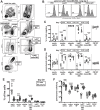Type I IFN Induction via Poly-ICLC Protects Mice against Cryptococcosis
- PMID: 26252005
- PMCID: PMC4529209
- DOI: 10.1371/journal.ppat.1005040
Type I IFN Induction via Poly-ICLC Protects Mice against Cryptococcosis
Abstract
Cryptococcus neoformans is the most common cause of fungal meningoencephalitis in AIDS patients. Depletion of CD4 cells, such as occurs during advanced AIDS, is known to be a critical risk factor for developing cryptococcosis. However, the role of HIV-induced innate inflammation in susceptibility to cryptococcosis has not been evaluated. Thus, we sought to determine the role of Type I IFN induction in host defense against cryptococci by treatment of C. neoformans (H99) infected mice with poly-ICLC (pICLC), a dsRNA virus mimic. Unexpectedly, pICLC treatment greatly extended survival of infected mice and reduced fungal burdens in the brain. Protection from cryptococcosis by pICLC-induced Type I IFN was mediated by MDA5 rather than TLR3. PICLC treatment induced a large, rapid and sustained influx of neutrophils and Ly6Chigh monocytes into the lung while suppressing the development of eosinophilia. The pICLC-mediated protection against H99 was CD4 T cell dependent and analysis of CD4 T cell polyfunctionality showed a reduction in IL-5 producing CD4 T cells, marginal increases in Th1 cells and dramatic increases in RORγt+ Th17 cells in pICLC treated mice. Moreover, the protective effect of pICLC against H99 was diminished in IFNγ KO mice and by IL-17A neutralization with blocking mAbs. Furthermore, pICLC treatment also significantly extended survival of C. gattii infected mice with reduced fungal loads in the lungs. These data demonstrate that induction of type I IFN dramatically improves host resistance against the etiologic agents of cryptococcosis by beneficial alterations in both innate and adaptive immune responses.
Conflict of interest statement
I have read the journals policy and have the following conflicts: AMS is employed by the commercial company Oncovir. This does not alter our adherence to all PLOS Pathogens policies on sharing data and materials.
Figures






Similar articles
-
Exogenous Stimulation of Type I Interferon Protects Mice with Chronic Granulomatous Disease from Aspergillosis through Early Recruitment of Host-Protective Neutrophils into the Lung.mBio. 2018 Mar 27;9(2):e00422-18. doi: 10.1128/mBio.00422-18. mBio. 2018. PMID: 29588403 Free PMC article.
-
Pulmonary Iron Limitation Induced by Exogenous Type I IFN Protects Mice from Cryptococcus gattii Independently of T Cells.mBio. 2019 Jun 18;10(3):e00799-19. doi: 10.1128/mBio.00799-19. mBio. 2019. PMID: 31213551 Free PMC article.
-
Poly-ICLC preconditioning protects the blood-brain barrier against ischemic injury in vitro through type I interferon signaling.J Neurochem. 2012 Nov;123 Suppl 2(Suppl 2):75-85. doi: 10.1111/j.1471-4159.2012.07946.x. J Neurochem. 2012. PMID: 23050645 Free PMC article.
-
Poly-ICLC, a multi-functional immune modulator for treating cancer.Semin Immunol. 2020 Jun;49:101414. doi: 10.1016/j.smim.2020.101414. Epub 2020 Oct 1. Semin Immunol. 2020. PMID: 33011064 Review.
-
Poly(I:C) as cancer vaccine adjuvant: knocking on the door of medical breakthroughs.Pharmacol Ther. 2015 Feb;146:120-31. doi: 10.1016/j.pharmthera.2014.09.010. Epub 2014 Oct 2. Pharmacol Ther. 2015. PMID: 25281915 Review.
Cited by
-
Cryptococcus neoformans Infection in the Central Nervous System: The Battle between Host and Pathogen.J Fungi (Basel). 2022 Oct 12;8(10):1069. doi: 10.3390/jof8101069. J Fungi (Basel). 2022. PMID: 36294634 Free PMC article. Review.
-
Chronic infection control relies on T cells with lower foreign antigen binding strength generated by N-nucleotide diversity.PLoS Biol. 2024 Feb 1;22(2):e3002465. doi: 10.1371/journal.pbio.3002465. eCollection 2024 Feb. PLoS Biol. 2024. PMID: 38300945 Free PMC article.
-
Exogenous Stimulation of Type I Interferon Protects Mice with Chronic Granulomatous Disease from Aspergillosis through Early Recruitment of Host-Protective Neutrophils into the Lung.mBio. 2018 Mar 27;9(2):e00422-18. doi: 10.1128/mBio.00422-18. mBio. 2018. PMID: 29588403 Free PMC article.
-
Cryptococcal therapies and drug targets: the old, the new and the promising.Cell Microbiol. 2016 Jun;18(6):792-9. doi: 10.1111/cmi.12590. Epub 2016 Apr 8. Cell Microbiol. 2016. PMID: 26990050 Free PMC article. Review.
-
MDA5 signaling induces type 1 IFN- and IL-1-dependent lung vascular permeability which protects mice from opportunistic fungal infection.Front Immunol. 2022 Jul 28;13:931194. doi: 10.3389/fimmu.2022.931194. eCollection 2022. Front Immunol. 2022. PMID: 35967332 Free PMC article.
References
-
- Bicanic T, Harrison TS. Cryptococcal meningitis. Br Med Bull. 2004; 72: 99–118. - PubMed
-
- Levy JA. HIV and the pathogenesis of AIDS. Washington DC: American Society of Microbiology; 1998.
Publication types
MeSH terms
Substances
LinkOut - more resources
Full Text Sources
Other Literature Sources
Research Materials

